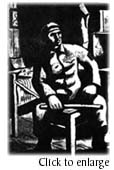| The SS tried to prevent solidarity among the prisoners
by dividing them by nationality and also according to such categories as
"politicals", "homosexuals", "Jehova`s Witnesses",
"deviants", "Jews" and "Gypsies". They created a caste
system, as well, so that, e.g., a German prisoner was ranked by the SS above a Polish Jew.
The first to arrive were the "criminals" and "deviants" who came to
Flossenbuerg in 1938. The survivors from the 1000 prisoners who had been sent from Dachau
in the autumn of 1939 were transported back there early in 1940. In April, 1940 followed
the first non-German prisoners from the "protectorates" of Bohemia and Moravia.
In the last phase, beginning in 1942, the population came to include prisoners from all
the occupied countries: Frenchmen, Dutsch, Belgians, Czechs, Russians, Poles, Greeks,
Italians, Slovaks and Hungarians. In the end the population in Flossenbuerg and its
outlying camps included prisoners from 30 countries, a total of more than 100,000 inmates. The
"A wing" of every prisoners´ barrack was controlled by the "block
senior", the "B wing", by "the writer" who had a bed and a desk
there. While the block seniors were so-called "greens" (criminals), the writers
were frequently political prisoners. Many of these privileged prisoners,
("capos"), became cruel accomplices who gave murdered prisoners over to the SS
in return for cigarettes or brandy, for the SS guards received a special three or four day
holiday for each prisoner killed.
If the capo refused to act with the compliance or violence demanded by the SS, he had
to reckon with being deposed and sometimes with being lynched by this fellow prisoners.
The more cruelty he showed, however, the more he had to depend on the SS. This type of
"prisoner selfgovernment" was an attempt by the SS to prevent solidarity among
the prisoners. |

|

